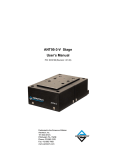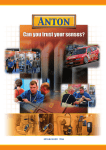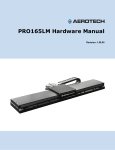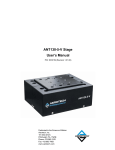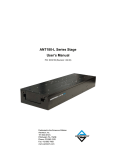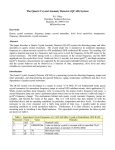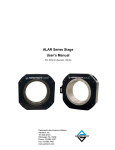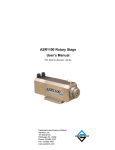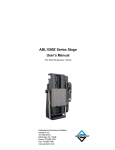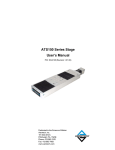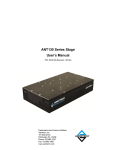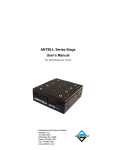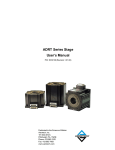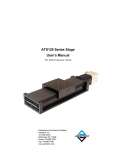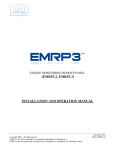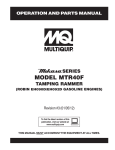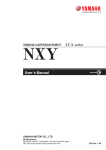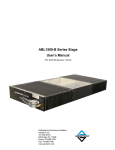Download My Document
Transcript
AirLift 115 Series Lift Stage User’s Manual P/N: EDS155 (Revision 1.01.00) Dedicated to the Science of Motion Aerotech, Inc. 101 Zeta Drive, Pittsburgh, PA, 15238 Phone: 412-963-7470 Fax: 412-963-7459 www.aerotech.com Product Registration Register online at: http://www.aerotech.com/prodreg.cfm Technical Support United States Headquarters: Phone: (412) 967-6440 Fax: (412) 967-6870 Email: [email protected] United Kingdom: Phone: +44 118 940 9400 Fax: +44 118 940 9401 Email: [email protected] Germany: Phone: +49 911 967 9370 Fax: +49 911 967 93720 Email: [email protected] Japan: Phone: +81(0)47-489-1741 (Sales) Phone: +81(0)47-489-1742 (Service) Fax: +81(0)47-489-1743 Email: [email protected] China: Phone: +852-3793-3488 Email: [email protected] Revision History Revision 1.01.00 December 16, 2010 Revision 1.00.00 February 26, 2010 Product names mentioned herein are used for identification purposes only and may be trademarks of their respective companies. © Aerotech, Inc. 2010 AirLift 115 Series Stage User's Manual Table of Contents Table of Contents Table of Contents List of Figures List of Tables iii v vii Chapter 1: Overview 1 1.1. Standard Features 1.1.1. Optional Features 1.2. Dimensions 1.3. Safety Procedures and Warnings 1.4. EC Declaration of Incorporation Chapter 2: Installation 2.1. Unpacking and Handling the Stage 2.2. Air Supply Requirements 2.3. Attaching the Payload to the Stage 2.4. Electrical Installation 2.4.1. End of Travel Limit Switches 2 3 4 6 8 9 9 11 11 12 12 Chapter 3: Operating Specifications 13 3.1. Environmental Specifications 3.2. Accuracy and Temperature Effects 3.3. Basic Specifications 3.4. Limit Switches 3.4.1. Limit Switch Operation 3.4.2. Limit Switch Wiring 3.5. Standard Motor Wiring 3.6. Vacuum Operation 13 13 14 16 16 16 17 19 Chapter 4: Maintenance 4.1. Service and Inspection Schedule 4.2. Cleaning and Lubrication 4.2.1. Recommended Cleaning Solvents 4.2.2. Cleaning Process 4.2.3. Ballscrew Lubrication Procedure 21 21 21 21 22 23 Appendix A: Warranty and Field Service 25 Appendix B: Technical Changes 27 Index 29 Reader's Comments 31 www.aerotech.com iii Table of Contents iv AirLift 115 Series Stage User's Manual www.aerotech.com AirLift 115 Series Stage User's Manual List Of Figures List of Figures Figure 1-1: Figure 1-2: Figure 1-3: Figure 1-4: Figure 2-1: Figure 3-1: Figure 3-2: Figure 3-3: Figure 3-4: Figure 4-1: Figure 4-2: Figure 4-3: Typical AirLift 115 Series Positioning Stage AirLift 115 Series Stage Components AirLift 115 Mounting Configuration 1 Dimensions AirLift 115 Mounting Configuration 2 Dimensions AirLift 115 With Lifting Hardware and Shipping Brackets Shown Limit Switch Wiring Limit and Encoder Wiring for Standard AirLift 115 Stages Limit Encoder Pin Assignments Motor Wiring Connector for all AirLift 115 Stages Air Bearing Surfaces and Encoder Scales Require Periodic Cleaning Cover Plate Mounting Screw Removal Grease Fitting and Hard Stop Location www.aerotech.com 1 2 4 5 10 16 17 18 18 22 23 24 v List of Figures vi AirLift 115 Series Stage User's Manual www.aerotech.com AirLift 115 Series Stage User's Manual List of Tables List of Tables Table 1-1: Table 3-1: Table 3-2: Table 3-3: Table 3-4: Table B-1: Table B-2: Model Numbering System Environmental Specifications AirLift 115 Series Specifications Motor Specifications Limit/Motor Wiring Pin Descriptions Current Changes (1.01.00) Archived Changes www.aerotech.com 3 13 14 15 19 27 28 vii List of Tables viii AirLift 115 Series Stage User's Manual www.aerotech.com AirLift 115 Series Stage User's Manual Overview Chapter 1: Overview This manual describes Aerotech’s AirLift 115 series of air bearing positioning stages. Figure 1-1 shows a typical AirLift 115 positioning stage. This chapter introduces standard and optional features of the AirLift 115 stages and gives general safety precautions. The AirLift 115 is a single axis air-bearing lift stage, available in travels of 50 mm, 100 mm, and 150 mm. Figure 1-1: Typical AirLift 115 Series Positioning Stage N O T E : Aerotech continually improves its product offerings, and listed options may be superseded at any time. Refer to the most recent edition of the Aerotech Motion Control Product Guide for the most current product information at www.aerotech.com. www.aerotech.com Chapter 1 1 Overview AirLift 115 Series Stage User's Manual 1.1. Standard Features The AirLift 115 series stages offer an ideal solution for applications that require stringent Z direction positioning while maintaining extremely tight angular performance over full travel. Applications include semiconductor wafer inspection and testing, non-contact metrology, optical inspection systems, and laser processing applications. The AirLift 115 incorporates air-on-air preload in the lateral directions of motion. The opposing thin-film pressure maintains the bearing nominal gap tolerance. This design, in addition to the large air-bearing surfaces that distribute the load over a large surface area, results in a stage with outstanding stiffness. Aerotech's BMS series of brushless rotary motors are included with the AirLift 115 series stages. This motor has all the advantages of a brushless motor: high acceleration, no brushes to wear, and lower heating, yet it has zero cogging for extremely smooth motion and accuracy. BMS motors for AirLift 115 are fitted with a failsafe brake, which, coupled with the precision ground ballscrew drive, eliminates the need for the pneumatic counterbalance typically seen on vertical air bearing stages. Limit switches and mechanical shock absorbers, which protect the carriage from over travel, are also standard. Figure 1-2: 2 AirLift 115 Series Stage Components Chapter 1 www.aerotech.com AirLift 115 Series Stage User's Manual Overview 1.1.1. Optional Features Custom designed AirLift 115 stages can be ordered with features such as higher resolution, custom travel lengths, and custom mounting options. The standard options for the AirLift 115 are shown in Table 1-1. Contact the Aerotech factory for more details about custom designed stages. Table 1-1: Model Numbering System AirLift 115 Travel Options AirLift 115050 50 mm travel AirLift 115100 100 mm travel AirLift 115150 150 mm travel Encoder Options -LTX100 Linear encoder for AirLift 115; 0.05 micron line-driver output Motor Options -BMS60-BRK Brushless servomotor with connectors and brake -BMS100BRK Brushless servomotor with connectors and brake Mounting -MT1 Mounting configuration 1; mounting surface perpendicular to axis motion -MT2-050 Mounting configuration 2; mounting surface parallel to axis motion; for 50 mm travel stage -MT2-100 Mounting configuration 2; mounting surface parallel to axis motion; for 100 mm travel stage -MT2-150 Mounting configuration 2; mounting surface parallel to axis motion; for 150 mm travel stage www.aerotech.com Chapter 1 3 Overview AirLift 115 Series Stage User's Manual 1.2. Dimensions Figure 1-3: 4 AirLift 115 Mounting Configuration 1 Dimensions Chapter 1 www.aerotech.com AirLift 115 Series Stage User's Manual Figure 1-4: www.aerotech.com Overview AirLift 115 Mounting Configuration 2 Dimensions Chapter 1 5 Overview AirLift 115 Series Stage User's Manual 1.3. Safety Procedures and Warnings The following statements apply throughout this manual. Failure to observe these precautions could result in serious injury to those performing the procedures and damage to the equipment. This manual and any additional instructions included with the stage should be retained for the lifetime of the stage. To minimize the possibility of electrical shock and bodily injury or death, disconnect all electrical power prior to making any electrical connections. To minimize the possibility of electrical shock and bodily injury or death when any electrical circuit is in use, ensure that no person comes in contact with the circuitry when the stage is connected to a power source. To minimize the possibility of bodily injury or death, disconnect all electrical power prior to making any mechanical adjustments. Moving parts of the stage can cause crushing or shearing injuries. All personnel must remain clear of any moving parts. Improper use of the stage can cause damage, shock, injury, or death. Read and understand this manual before operating the stage. If the stage is used in a manner not specified by the manufacturer, the protection provided by the stage can be impaired. Stage cables can pose a tripping hazard. Securely mount and position all stage cables to avoid potential hazards. 6 Chapter 1 www.aerotech.com AirLift 115 Series Stage User's Manual Overview Do not expose the stage to environments or conditions outside the specified range of operating environments. Operation in conditions other than those specified can cause damage to the equipment. The stage must be mounted securely. Improper mounting can result in injury and damage to the equipment. Use care when moving the stage. Manually lifting or transporting stages can result in injury. Only trained personnel should operate, inspect, and maintain the stage. This stage is intended for light industrial manufacturing or laboratory use. Use of the stage for unintended applications can result in injury and damage to the equipment. Before using this stage, perform an operator risk assessment to determine the needed safety requirements. www.aerotech.com Chapter 1 7 Overview AirLift 115 Series Stage User's Manual 1.4. EC Declaration of Incorporation Manufactorer: Aerotech, Inc. 101 Zeta Drive Pittsburgh, PA 15238 USA herewith declares that the product: Aerotech, Inc. AirLift 115 Stage is intended to be incorporated into machinery to constitute machinery covered by the Directive 2006/42/EC as amended; does therefore not in every respect comply with the provisions of this directive; and that the following harmonized European standards have been applied: EN ISO 12100-1,-2:2003+A1:2009 Safety of machinery - Basic concepts, general principles for design ISO 14121-1:2007 Safety of machinery - Risk assessment - Par 1: Principles EN 60204-1:2005 Safety of machinery - Electrical equipment of machines - Part 1: General requirements and further more declares that it is not allowed to put the equipment into service until the machinery into which it is to be incorporated or of which it is to be a component has been found and declared to be in conformity with the provisions of the Directive 2006/42/EC and with national implementing legislation, i.e. as a whole, including the equipment referred to in this Declaration. Authorized Representative: Address: Manfred Besold AEROTECH GmbH Süd-West-Park 90 D-90449 Nürnberg Name: Position: Location: Date: 8 Alex Weibel / Engineer Verifying Compliance Pittsburgh, PA December 16, 2010 Chapter 1 www.aerotech.com AirLift 115 Series Stage User's Manual Installation Chapter 2: Installation This chapter describes the installation procedure of the AirLift 115 stage, including handling the stage properly, the proper base for stage mounting, attaching the payload, and making the electrical and pneumatic connections. Installation must follow the instructions in this chapter. Failure to follow these instructions could result in injury and damage to the equipment. 2.1. Unpacking and Handling the Stage Each stage has a label listing the system part number and serial number. These numbers contain information necessary for maintaining or updating system hardware and software. Locate this label and record the information for later reference. If any damage has occurred during shipping, report it immediately. Before operating the stage, it is important to let the stage stabilize to room temperature for at least 12 hours. Clean the stage by blowing it off with pressurized nitrogen or clean, oil-free air. Remove all red anodized shipping brackets and lifting hardware before attempting to move the axis (see Figure 2-1). Improper stage handling could adversely affect the stage’s performance. Therefore, use care when moving the stage. Manually lifting or transporting the stage can result in injury. Lift the stage only by the provided lifting hardware. Do not attempt to move the stage until the air supply, detailed in Section 2.2. , has been installed. Moving the stage table without air supplied can cause permanent damage to the stage. www.aerotech.com Chapter 2 9 Installation AirLift 115 Series Stage User's Manual Figure 2-1: 10 AirLift 115 With Lifting Hardware and Shipping Brackets Shown Chapter 2 www.aerotech.com AirLift 115 Series Stage User's Manual Installation 2.2. Air Supply Requirements The quality of the air supplied to the air bearing is important for the operation of the system. If compressed air is used, it must be filtered to 0.25 microns, dry to 0°F dew point, and oil free. If nitrogen is used, it must be 99.99% pure and filtered to 0.25 microns. The filtration requirement is to prevent particles from clogging the air bearing. Air pressure in the range of 517 kPa to 551 kPa (75 psi to 80 psi) is necessary for use. A standard airflow rate of 45 to 55 SLPM (standard liters per minute) at 551 kPa should be observed for the entire system. To protect the air bearing against under pressure or loss of pressure, an inline pressure switch set at no lower than 40 psi and tied to the motion controller's E-stop is recommended. 2.3. Attaching the Payload to the Stage To prevent damage to delicate payloads, test the operation of the stage before the payload is attached to the stage table. Proceed with the electrical installation and test the motion control system in accordance with the system documentation. Document all results for future reference. For information on electrical connections, refer to Section 2.4. The payload should be flat, rigid, and comparable to the stage in quality. For valid accuracies, the mounting interface should be flat within 1µm per 50mm. www.aerotech.com Chapter 2 11 Installation AirLift 115 Series Stage User's Manual 2.4. Electrical Installation Electrical installation requirements will vary depending on stage options. Installation instructions in this section are for stages equipped with standard Aerotech motors intended for use with an Aerotech motion control system. Contact Aerotech for further information regarding stages that are otherwise configured. Aerotech motion control systems are adjusted at the factory for optimum performance. When the AirLift 115 series stage is part of a complete Aerotech motion control system, setup involves connecting a stage and motor combination to the appropriate drive chassis with the cables provided. Connect the provided cables to the motor and feedback connectors on the stage. Labels on the drive indicate the appropriate connections. Refer to your drive manuals and documentation for additional installation and operation information. In some cases, if the system is uniquely configured, a drawing showing system interconnects is supplied. Motor and encoder wiring and connector pin outputs are given in Section 3.5. Never connect or disconnect any electrical component or connecting cable while power is applied, or serious damage may result. The stage's protective ground is located on pin A4 of the motor connector. If you are using cables other than those provided by Aerotech to connect the motor to the drive, you must connect pin A4 to a ground connection. 2.4.1. End of Travel Limit Switches AirLift 115 stages are equipped with a pair of end of travel limit switches. Refer to Section 3.4. for a description of limit switch operation and wiring. 12 Chapter 2 www.aerotech.com AirLift 115 Series Stage User's Manual Operating Specifications Chapter 3: Operating Specifications This chapter contains general technical information about AirLift 115 series stages. Included are basic product specifications and general information on limit switches and motor wiring. 3.1. Environmental Specifications The environmental specifications for the AirLift 115 are listed in the following table. Table 3-1: Environmental Specifications Ambient Temperature Operating: 10° to 35° C (50° to 95° F) The optimal operating temperature is 20° C ±2° C (68° F ±4° F). If at any time the operating temperature deviates from 20° C degradation in performance could occur. Contact Aerotech for information regarding your specific application and environment. Storage: 0° to 40° C (32° to 104° F) in original shipping packaging Humidity Operating: 40 percent to 60 percent RH The optimal operating humidity is 50 percent RH. Storage: 30 percent to 60 percent RH, non-condensing in original packaging Altitude Operating: 0 to 2,000 m (0 to 6,562 ft) above sea level Contact Aerotech if your specific application involves use above 2,000 m or below sea level. Vibration Use the system in a low vibration environment. Excessive floor or acoustical vibration can affect stage and system performance. Contact Aerotech for information regarding your specific application. Dust Exposure The AirLift 115 stages are not suited for dusty or wet environments. This equates to an ingress protection rating of IP00. Use Indoor use only Do not expose the stage to environments or conditions outside the specified range of operating environments. Operation in conditions other than those specified can cause damage to the equipment. 3.2. Accuracy and Temperature Effects The accuracy of the encoder scale is a key element in the overall positioning accuracy. In most stages, a scale error can be expected if the temperature of the scale differs from 20° C (68° F); however, the AirLift 115 is designed with encoder scales having vary small coefficients of thermal expansion (CTE). This feature makes the accuracy of the stage much less dependent on the operating temperature. Although the accuracy is much less sensitive to temperature than many systems, the best accuracy will still be achieved if the stage is operated at the 20° C (68° F) temperature at which it was calibrated. www.aerotech.com Chapter 3 13 Operating Specifications AirLift 115 Series Stage User's Manual 3.3. Basic Specifications Basic AirLift 115 series positioning stage specifications are shown in Table 3-2. For the most recent specifications, see Aerotech's website (www.aerotech.com). Table 3-2: AirLift 115 Series Specifications Mechanical Specifications Travel Accuracy(1) AirLift 115-050 AirLift 115-100 AirLift 115-150 50 mm 100 mm 150 mm Standard ±2.0 µm ±4.0 µm ±6.0 µm HALAR ±1.0 µm ±1.25 µm ±1.5 µm Resolution 0.05 µm Repeatability (Bidirectional) (1) ±0.5 µm Straightness(2) ±0.25 µm ±0.35 µm ±0.45 µm Pitch(2) ±1 arc sec ±1.25 arc sec ±2 arc sec Roll(2) ±1 arc sec ±1.25 arc sec ±2 arc sec Yaw(2) ±1 arc sec ±1.25 arc sec ±2 arc sec Maximum Speed 5 mm/rev 50 mm/s Maximum Acceleration Load Capacity(3) 0.25 g Vertical 15 kg Operating Pressure 80 psi Air Consumption ≤ 40 slpm Material Aluminum MTBF (Mean Time Between Failure) 15,000 Hours (1) Certified with each stage. (2) Specifications are for centered load. Other loading configurations will affect specifications. (3) Axis orientation for on-axis loading is listed. (4) Specifications are for single-axis systems measured 25 mm above the tabletop. Performance of multi-axis systems is payload and workpoint dependent. Consult factory for multi-axis or non-standard applications. (5) To protect air bearing against under-pressure condition, an in-line pressure switch tied to the motion controller is required. (6) Air supply must be clean, dry to 0°F dew point, and filtered to 0.25 µm or better. 14 Chapter 3 www.aerotech.com AirLift 115 Series Stage User's Manual Table 3-3: Operating Specifications Motor Specifications Units Specifications Motor Model BMS60-BRK BMS100-BRK -A -A N-m (oz-in) 0.33 (46.2) 0.56 (80.0) Winding Designation Performance Specifications (1) (5) Stall Torque, Continuous (2) Peak Torque (3) N-m (oz-in) 1.31 (184.9) 2.26 (320.0) Rated Speed rpm 4,000 3,000 Rated Power Output, Continuous watts 112 133 Voltspk/krpm 19 40 (2) Amppk Amprms 2.3 1.6 2.1 1.5 Peak Current, Stall (3) Amppk Amprms 9.2 6.5 8.4 5.9 N-m/Amppk oz-in/Amppk 0.14 20.1 0.27 38.1 N-m/Amprms oz-in/Amprms 0.20 28.4 0.38 53.9 N-m/√W oz-in/√W 0.050 7.02 0.076 10.74 Resistance, 25°C (LineLine) ohms 8.4 12.9 Inductance (Line-Line) mH 1.30 2.40 Maximum Bus Voltage VDC 340 340 Thermal Resistance C/W 1.73 1.35 P 8 8 Electrical Specifications (5) BEMF Constant (Line-Line, Max) Continuous Current, Stall Torque Constant (4) (8) Motor Constant (2) (4) Number of Poles Mechanical Specifications Motor Weight kg (lb) 1.1 (2.4) 1.5 (3.3) kg-m2 oz-in-s2 1.96x10-5 0.0028 3.71x10-5 0.0053 N (lb) 89 (20) 89 (20) Max Axial Load N (lb) 89 (20) 89 (20) Frame Size NEMA 23 23 Rotor Moment of Inertia Max Radial Load (1) Performance is dependent upon heat sink configuration, system cooling conditions, and ambient temperature. (2) Values shown @ 75°C rise above a 25°C ambient temperature, with housed motor mounted to a 250 mm x 250 mm x 6 mm aluminum heat sink. (3) Peak torque assumes correct rms current; consult Aerotech. (4) Torque constant and motor constant specified at stall. (5) All performance and electrical specifications ±10%. (6) Maximum winding temperature is 100°C; thermistor trips at 100°C. (7) Ambient operating temperature range 0°C - 25°C. Consult Aerotech for performance in elevated ambient temperatures. (8) All Aerotech amplifiers are rated Apk; use torque constant in N-m/Apk when sizing. www.aerotech.com Chapter 3 15 Operating Specifications AirLift 115 Series Stage User's Manual 3.4. Limit Switches AirLift 115 series stages are provided with end of travel limit switches. The limit switches signal when the stage has reached its maximum useable travel distance in either direction. 3.4.1. Limit Switch Operation Limit switches are integral to the stage's linear encoder. They are placed directly on the encoder scale at the extents of nominal stage travel. When the stage encoder senses a limit, a clockwise (CW) or counterclockwise (CCW) limit signal is generated. If the stage is driven past the electrical limit, it will encounter the hard stop. The stage's shocks are designed to the stage's specifications. Damage to the stage could result from a hard stop strike if the stage is driven at conditions exceeding its maximum velocity, acceleration, or payload specifications. 3.4.2. Limit Switch Wiring Limit switches are open-collector, TTL–compatible devices powered by 5 Volts that change output states when the stage approaches its maximum travel distance. Since they are open-collector devices, they may be interfaced to 24 Volt logic inputs. With the NC limit configuration, the input to the controller is seen as a logic 0 (typical 0.4V @ 12.8mA) when no limit condition is present. When the limit switch is activated, a 5V source through a pull-up resistor, on the controller, causes a logic 1 (typically 4.8-5V) to be seen by the controller input. See Figure 3-1 for a diagram of limit switch wiring. Figure 3-1: 16 Limit Switch Wiring Chapter 3 www.aerotech.com AirLift 115 Series Stage User's Manual Operating Specifications 3.5. Standard Motor Wiring Stages fitted with standard motors and encoders come from the factory completely wired and assembled. For reference, connector pin outputs and general wiring information are given in the following figures. Pin outputs are defined in Table 3-4. N O T E : Refer to the other documentation accompanying your Aerotech equipment. Call your Aerotech representative if there are any questions on system configuration. N O T E : If you are using your own cables to connect the stage, ensure that motor and ground wires can handle current higher than the continuous current listed in Table 3-3. The voltage rating of the wire insulation must be greater than the bus voltage listed in Table 3-3. Figure 3-2: www.aerotech.com Limit and Encoder Wiring for Standard AirLift 115 Stages Chapter 3 17 Operating Specifications AirLift 115 Series Stage User's Manual Figure 3-3: Figure 3-4: 18 Limit Encoder Pin Assignments Motor Wiring Connector for all AirLift 115 Stages Chapter 3 www.aerotech.com AirLift 115 Series Stage User's Manual Table 3-4: Operating Specifications Limit/Motor Wiring Pin Descriptions Pin Output CW Limit Description Signal indicating stage maximum travel produced by CW motor rotation (Normally Active High). COS Cosine. Incremental encoder output; either TTL line driven or amplified sine wave type signal. Cos leads Sin for CW/positive motion. COS-N Incremental encoder output. Compliment of cos. Counterclockwise (CCW/-) Limit Signal indicating stage maximum travel produced by CCW motor rotation (Normally Active High). HOME LMT Home Limit. Paralleled with CCW/- (with Standard Jumper) or CW/+ (Optional Jumper) limit. Typically not used. ENC +5V +5 V supply input for optical encoders. Typical requirement is 250 mA. ENC COM Optical encoder common. HA Hall Effect A. Brushless motor commutation track output. TTL line driven signal HB Hall Effect B. Brushless motor commutation track output. TTL line driven signal. HC Hall Effect C. Brushless motor commutation track output. TTL line driven signal LMT +5v + 5 V supply input for optical limit switch boards. Typical requirement is 50 mA. LMT COM Optical limit switch boards common. MKR Marker. Incremental encoder output pulse given once per revolution. Typically used for home reference cycle. MKR-N Incremental encoder output; either the compliment of Marker with a line driven, TTL type encoder or 2.5 VDC bias level with amplified sine wave type encoder. MTR ØA Motor Phase A. MTR ØB Motor Phase B. MTR ØC Motor Phase C. SIN Sine. Incremental encoder output; either TTL line driven or amplified sine wave type signal. Cos leads sin for CW/positive motion. SIN-N Incremental encoder output. Compliment of sin. 3.6. Vacuum Operation The AirLift 115 is an air-bearing stage and is not compatible with operation in a vacuum environment. Contact Aerotech for alternate solutions. www.aerotech.com Chapter 3 19 Operating Specifications 20 AirLift 115 Series Stage User's Manual Chapter 3 www.aerotech.com AirLift 115 Series Stage User's Manual Maintenance Chapter 4: Maintenance AirLift 115 stages are designed to be low maintenance systems. The non-contact air bearing surfaces require no lubrication, and exhibit no wear. However, it is important to clean the bearing surfaces to maintain the accuracy of the stage. You must lubricate the precision ground ballscrew drive at regular intervals. This chapter will detail the cleaning process and specify recommended cleaning solvents. N O T E : The bearing area must be kept free of foreign matter and moisture; otherwise, the performance and life expectancy of the stage will be reduced. See Section 2.2. for air requirements. To minimize the possibility of bodily injury, confirm that all electrical power is disconnected prior to making any mechanical adjustments. 4.1. Service and Inspection Schedule Lubricant inspection and replenishment for AirLift 115 series stages depends on conditions such as duty cycle, speed, and operating environment. An inspection interval of once per month is recommended until a trend develops for the application. The grease should be fresh and soft and evenly distributed over the entire length of the screw shaft. Longer or shorter inspection intervals might be required to maintain a film of lubricant on the ballscrew. If the stage is under a high duty cycle, it might be necessary to lubricate the screw as often as once per week. If the application process uses only a small portion of travel for most of the duty cycle, you should periodically drive the stage through the full travel to redistribute the lubrication along the screw shaft. The ballscrew support bearings are sealed and should not need lubrication under normal use. 4.2. Cleaning and Lubrication Only the ballscrew of the AirLift 115 stage requires lubrication. Periodic cleaning to remove dust from the stage is also recommended. 4.2.1. Recommended Cleaning Solvents Before using a cleaning solvent on any part of the stage, use Nitrogen, or less preferably, clean, dry compressed air to blow away small particles and dust. For general cleaning and removal of dust, use only isopropyl alcohol on AirLift 115 stages. Do not use acetone on AirLift 115 stages. Isopropyl alcohol should be conservatively applied to a clean, lint free cloth, and the cloth should be used to wipe down the stage. Do not use an excessive amount of solvent as it could enter the body of the stage and potentially damage the air bearing. The AirLift 115 ballscew drive requires periodic lubrication. THK AFE-CA cleanroom rated grease is applied to the ballscrew during assembly at Aerotech's factory. For maintenance lubrication, use only THK AFE-CA grease. Greases of different physical properties cannot be mixed, and doing so could degrade the performance of the stage and eventually cause stage failure. www.aerotech.com Chapter 4 21 Maintenance AirLift 115 Series Stage User's Manual 4.2.2. Cleaning Process It is recommended that the air bearing surfaces be cleaned often to prevent potential damage to the stage or decreased performance. Blow the entire stage with Nitrogen or clean, dry, compressed air often to prevent dust form building up on the stage. In order to clean the entire length of the air bearing surfaces, it is necessary to move the stage to the positive travel limit, thereby extending the carriage out of the stage base the maximum amount. Remove any obstructions that could potentially interfere with motion of the carriage, then jog the stage to the positive travel limit. Once the stage is in position, disable the axis and remove power to the stage. Clean all exposed surfaces as described in Section 4.2.1. Once the solvent has dried, you can restore power. Moving the stage table without air supplied can cause permanent damage to the stage. Refer to Section 2.2. for more information about air requirements and installation. To minimize the possibility of bodily injury, confirm that all electrical power is disconnected prior to making any mechanical adjustments. Figure 4-1: 22 Air Bearing Surfaces and Encoder Scales Require Periodic Cleaning Chapter 4 www.aerotech.com AirLift 115 Series Stage User's Manual Maintenance 4.2.3. Ballscrew Lubrication Procedure Use the following steps to lubricate the ballscrew. As stated in Section 4.2.1. , use only THK AFE-CA grease for lubrication. To minimize the possibility of bodily injury, confirm that all electrical power is disconnected prior to making any mechanical adjustments. 1. Jog the stage carriage to the negative travel limit and remove power to the stage. 2. Remove the mounting screws to the cover plate on the side of the stage as shown in Figure 4-2 to gain access to the inside of the stage. Figure 4-2: Cover Plate Mounting Screw Removal 3. The ballnut and grease fitting should be visible through the window as shown in Figure 4-3. Engage a grease gun with appropriate attachment over the ballscrew's grease fitting. AirLift 115 stages use grease fitting THK# C-MT6x1, and THK's grease gun MG70 with a Type H attachment is recommended. www.aerotech.com Chapter 4 23 Maintenance AirLift 115 Series Stage User's Manual Figure 4-3: Grease Fitting and Hard Stop Location 4. Generally, it is recommended that grease be pumped into the ballnut until it just begins to seep out of the nut and onto the screw shaft. On AirLift 115 stages, this can be difficult to see. Use caution when pumping grease as applying too much can significantly increase the torque required to drive the stage and prevent lubrication from being evenly dispersed along the screw shaft. Remove any clumps of excess grease and wipe down any surfaces other than the ballscrew that may have come in contact with the grease. 5. After the ballnut has been properly greased, reinstall the cover plate, and restore power to the stage. 6. Slowly cycle the stage back and forth through travel for a minimum of 10 cycles to distribute the lubrication. 24 Chapter 4 www.aerotech.com AirLift 115 Series Stage User's Manual Warranty and Field Service Appendix A: Warranty and Field Service Aerotech, Inc. warrants its products to be free from defects caused by faulty materials or poor workmanship for a minimum period of one year from date of shipment from Aerotech. Aerotech's liability is limited to replacing, repairing or issuing credit, at its option, for any products that are returned by the original purchaser during the warranty period. Aerotech makes no warranty that its products are fit for the use or purpose to which they may be put by the buyer, where or not such use or purpose has been disclosed to Aerotech in specifications or drawings previously or subsequently provided, or whether or not Aerotech's products are specifically designed and/or manufactured for buyer's use or purpose. Aerotech's liability or any claim for loss or damage arising out of the sale, resale or use of any of its products shall in no event exceed the selling price of the unit. Aerotech, Inc. warrants its laser products to the original purchaser for a minimum period of one year from date of shipment. This warranty covers defects in workmanship and material and is voided for all laser power supplies, plasma tubes and laser systems subject to electrical or physical abuse, tampering (such as opening the housing or removal of the serial tag) or improper operation as determined by Aerotech. This warranty is also voided for failure to comply with Aerotech's return procedures. Laser Products Claims for shipment damage (evident or concealed) must be filed with the carrier Return Procedure by the buyer. Aerotech must be notified within (30) days of shipment of incorrect materials. No product may be returned, whether in warranty or out of warranty, without first obtaining approval from Aerotech. No credit will be given nor repairs made for products returned without such approval. Any returned product(s) must be accompanied by a return authorization number. The return authorization number may be obtained by calling an Aerotech service center. Products must be returned, prepaid, to an Aerotech service center (no C.O.D. or Collect Freight accepted). The status of any product returned later than (30) days after the issuance of a return authorization number will be subject to review. After Aerotech's examination, warranty or out-of-warranty status will be determined. If upon Aerotech's examination a warranted defect exists, then the product(s) will be repaired at no charge and shipped, prepaid, back to the buyer. If the buyer desires an airfreight return, the product(s) will be shipped collect. Warranty repairs do not extend the original warranty period. Returned Product Warranty Determination After Aerotech's examination, the buyer shall be notified of the repair cost. At such Returned Product time, the buyer must issue a valid purchase order to cover the cost of the repair and Non-warranty Deterfreight, or authorize the product(s) to be shipped back as is, at the buyer's mination expense. Failure to obtain a purchase order number or approval within (30) days of notification will result in the product(s) being returned as is, at the buyer's expense. Repair work is warranted for (90) days from date of shipment. Replacement components are warranted for one year from date of shipment. At times, the buyer may desire to expedite a repair. Regardless of warranty or outof-warranty status, the buyer must issue a valid purchase order to cover the added rush service cost. Rush service is subject to Aerotech's approval. www.aerotech.com Appendix A Rush Service 25 Warranty and Field Service AirLift 115 Series Stage User's Manual On-site Warranty If an Aerotech product cannot be made functional by telephone assistance or by Repair sending and having the customer install replacement parts, and cannot be returned to the Aerotech service center for repair, and if Aerotech determines the problem could be warranty-related, then the following policy applies: Aerotech will provide an on-site field service representative in a reasonable amount of time, provided that the customer issues a valid purchase order to Aerotech covering all transportation and subsistence costs. For warranty field repairs, the customer will not be charged for the cost of labor and material. If service is rendered at times other than normal work periods, then special service rates apply. If during the on-site repair it is determined the problem is not warranty related, then the terms and conditions stated in the following "On-Site Non-Warranty Repair" section apply. On-site Non-warranty If any Aerotech product cannot be made functional by telephone assistance or purRepair chased replacement parts, and cannot be returned to the Aerotech service center for repair, then the following field service policy applies: Aerotech will provide an on-site field service representative in a reasonable amount of time, provided that the customer issues a valid purchase order to Aerotech covering all transportation and subsistence costs and the prevailing labor cost, including travel time, necessary to complete the repair. Company Address Aerotech, Inc. 101 Zeta Drive Pittsburgh, PA 15238-2897 26 Phone: (412) 963-7470 Fax: (412) 963-7459 Appendix A www.aerotech.com AirLift 115 Series Stage User's Manual Technical Changes Appendix B: Technical Changes Table B-1: Current Changes (1.01.00) Section(s) Affected Section 1.4. Section 3.1. Chapter 2: Installation, Section 2.1. , Section 2.4. , and Section 1.3. Section 3.5. www.aerotech.com General Information Section added Section added Safety information and warnings added Note about motor wire current and voltage requirements added Appendix B 27 Technical Changes Table B-2: Revision 1.00.00 28 AirLift 115 Series Stage User's Manual Archived Changes Section(s) Affected -- General Information New manual Appendix B www.aerotech.com Index AirLift 115 Series Stage User's Manual Index Specifications 14 Standard Features A 2 Standard Motor Wiring Air Supply Requirements 11 Attaching the Payload 11 17 U Unpacking and Handling the Stage 9 B Ballscrew Lubrication W 23 Warnings 6 C 12 cables Cleaning 21-22 Cleaning Solvents 21 D Declaration of Incorporation 8 E Electrical Installation 12 encoders 17 Environmental Specifications 13 I Inspection Schedule 21 L Limit Switches 16 Lubrication 21 M model numbers 9 O Optional Features 3 S safety procedures www.aerotech.com 6 Index 29 AirLift 115 Series Stage User's Manual 30 Index Index www.aerotech.com Reader's Comments AirLift 115 Series Stage Manual P/N: EDS155, December 16, 2010 Revision 1.01.00 Please answer the questions below and add any suggestions for improving this document. Is the manual: Yes No Adequate to the subject Well organized Clearly presented Well illustrated How do you use this document in your job? Does it meet your needs? What improvements, if any, would you like to see? Please be specific or cite examples. Stage/Product Details Name Model # Title Serial # Company Name Date Shipped Address Customer Order # Aerotech Subsidiary Order # Email Mail your comments to: Fax to: Aerotech, Inc. 101 Zeta Drive Pittsburgh, PA 15238 U.S.A. 412-967-6870 Email: [email protected]








































